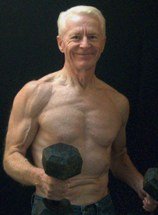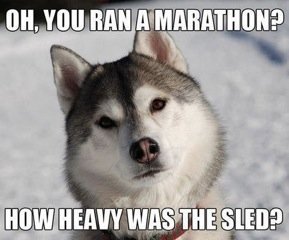| Back to Back Issues Page |
 |
|
The Gray Iron Fitness Newsletter, Issue #132, Avoid Exercise Burnout February 15, 2014 |
Hi
February 15, 2014
In this newsletter . . . Avoid exercise burnoutThe world's greatest athletes
Avoid exercise burnoutIn the beginner’s book for seniors, I explain a straight-line progression plan for building strength and fitness. You begin lifting a weight that is manageable without straining for 12 repetitions. At your next training session, you do 13 reps. Then 14 at the following workout and, finally, 15.Now you add weight to the bar, go back to doing 12 reps, and begin the progression over again. It works the same way with cardiovascular exercise. Suppose that you choose walking for cardio. At each workout, you add some minutes to your total. That is how classic straight-line strength and fitness progression works. (Note: Double progression training means doing two workouts before adding reps or weight to the bar, also a valid and sometimes useful method.) It is a solid beginner's program – for a while. But eventually you hit a wall. Call it what you want, a “sticking point,” a “plateau,” or whatever. The thing is if you simply try to push through it while doing the same things the same way, you inevitably experience physical or psychological burnout. The great Russian weightlifters realized this long ago and came up with an effective training protocol known as periodization. It works, more or less, like the following:
Following the active rest period, they would begin another cycle. Most who read this probably aren’t power lifters. Nevertheless, once you have progressed beyond the strength and fitness beginner stage, almost all training, whether it is for a particular sport or general good health and conditioning, should follow a somewhat similar format of: 1) gradual buildup; 2) peaking; and 3) backing off a bit (active rest). Why? Because no one can continually push to the limit at every workout and make progress. While on the subject, it should be noted that Russian lifters do not train to failure. Total, all-out efforts are reserved for competitions only. Most of us are not in competitions. Still, the principle remains the same. Test your limits once in a while, but trying for a personal best at every workout only leads to dreading your training, to possible injury, and to eventual failure. Once you have passed the beginner stage, my advice is to train with variety. Mix it up. Change your routine. Do high reps for a while. Then switch to medium reps with heavier weights or more resistance. For cardio, push yourself for a period. Point toward a goal. Reach it. Then back off and do something different and with less intensity for a couple of weeks. In the weight room, during all phases, keep your workouts short but focused. Not only will you make greater progress, you’ll enjoy your training more.
If you like the newsletter, we're making it easy to share it . . . The world's greatest athletesI consider myself a below-average sports fan. I cheer for a few teams, but if they lose I still sleep well at night. I’ve never called in to a sports-talk radio show.Of course there are exceptions to almost everything. My wife, Patty, is a middle-school teacher and one of her former students is the quarterback for a Division 1 college football team. We’re both emotional when it comes to his success. Another exception may surprise you. It has nothing whatsoever to do with the NFL, NBA, NHL, major league baseball, or the Olympics. Can’t guess what it is? Here is a hint: This sport truly features the world’s greatest athletes. I love the annual Iditarod, the 1,100-mile dog-sled race across the frozen wilderness of Alaska, in places about as forbidding and remote as it gets. Yet through the miracles of technology, GPS systems and computers, Iditarod fans can track and watch the mushers (dog-sled drivers) and their teams race from Anchorage to Nome. Do you wonder about my claim that the race “features the world’s greatest athletes”? Think for a moment about what sled dogs do. Imagine pulling loaded sleds up to a hundred miles per day, over snow and ice, day-after-day, often in sub-zero temperatures. Scientists are not sure how, but somehow, at the point of fatigue--when human athletes must rest or collapse--sled dogs seem to flip an internal switch that changes their metabolism. It allows them to pull a sled and musher for amazing distances under unthinkable conditions. How they manage this amazing internal transformation is still not clearly understood, but is being closely studied. When highly conditioned people, let’s take Tour de France competitors, as examples, push their physical limits day-after-day, they start to metabolize their body’s reserves. Simply put, when their cells run out of energy, fatigue sets in, until, finally, they cannot go on. Something different happens with sled dogs. Michael Davis is an associate professor of veterinary science at Oklahoma State University and does animal exercise research. Dr. Davis says, “Before the race, the dogs’ metabolic makeup is similar to humans. Then suddenly they throw a switch—-we don’t know what it is yet—-that reverses all of that. In a 24-hour period, they go back to the same type of metabolic baseline you see in resting subjects. But they do it while running 100 miles a day.” A typical sled dog racing over long distances burns, on average, 240 calories a pound per day for one or two weeks nonstop. While a Tour de France cyclist typically burns 100 calories per pound of weight daily. How the dogs maintain such a high level of caloric burn for extended periods without tapping into their reserves of fat and glycogen (and then grinding to a halt like we would) is the unsolved mystery. Could discovery benefit humans? Some scientists think so. Imagine being able to do extreme high-energy workouts, back-to-back, day-after-day, with joy and minimal fatigue.

Newsletter Policy The Gray Iron Fitness Newsletter is a free publication sent twice monthly to subscribers. The purpose is to provide honest and realistic fitness information for people age 50 and above. I have never been paid or received compensation of any kind to write a positive review or endorse a product. If I say that I personally use a product or service, it is because I find value in it and have paid for it with my own money. Like newspapers, magazines and television, this newsletter and my web site contain advertising and marketing links. Naturally, I am compensated for these. The newsletter and web site provide information to help users establish and maintain a fitness lifestyle. But fitness information is not the same as fitness advice, which is the application of exercise and dietary practices to an individual's specific circumstances. Therefore, always consult with your physician for assurance that fitness information, and your interpretation of it, is appropriate for you. Your comments and questions are always appreciated. Simply click on the "Reply" bottom. |
| Back to Back Issues Page |
